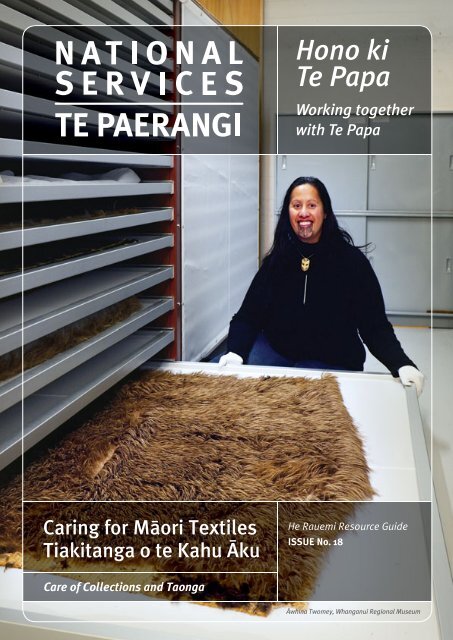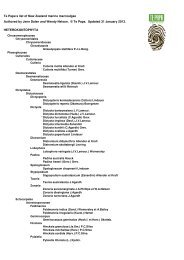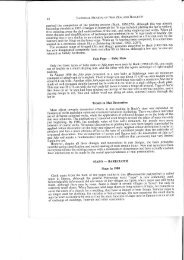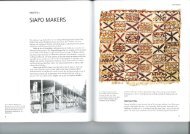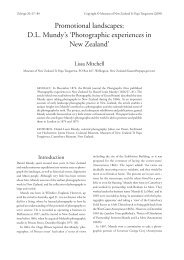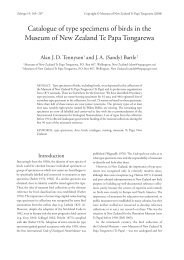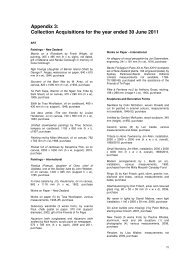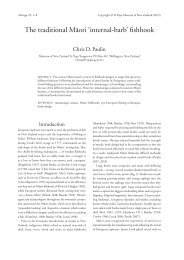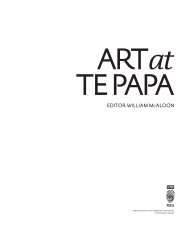Caring for Mäori Textiles Tiakitanga o te Kahu Äku - Te Papa
Caring for Mäori Textiles Tiakitanga o te Kahu Äku - Te Papa
Caring for Mäori Textiles Tiakitanga o te Kahu Äku - Te Papa
You also want an ePaper? Increase the reach of your titles
YUMPU automatically turns print PDFs into web optimized ePapers that Google loves.
<strong>Caring</strong> <strong>for</strong> <strong>Mäori</strong> <strong><strong>Te</strong>xtiles</strong><br />
<strong>Tiakitanga</strong> o <strong>te</strong> <strong>Kahu</strong> <strong>Äku</strong><br />
He Rauemi Resource Guide<br />
ISSUE No. 18<br />
Care of Collections and Taonga<br />
Äwhina Twomey, Whanganui Regional Museum
PO Box 467, Wellington, New Zealand<br />
Copyright © 2013 Museum of New Zealand<br />
<strong>Te</strong> <strong>Papa</strong> Tongarewa<br />
This National Services <strong>Te</strong> Paerangi Resource Guide<br />
is licensed under the Creative Commons Attribution-<br />
NonCommercial-NoDerivs 3.0 New Zealand License.<br />
To view a copy of this license, visit http://<br />
creativecommons.org/licenses/by-nc-nd/3.0/nz/<br />
For any further use not covered by this licence please<br />
contact natserv@<strong>te</strong>papa.govt.nz<br />
ISSN 1175-6462 (Print)<br />
ISSN 2253-1610 (Online)<br />
Cover Image: Photography by Leigh Mitchell-Anyon, 2013
<strong>Caring</strong> <strong>for</strong> <strong>Mäori</strong> <strong><strong>Te</strong>xtiles</strong> <strong>Tiakitanga</strong> o <strong>te</strong> <strong>Kahu</strong> <strong>Äku</strong><br />
Whiria <strong>te</strong> muka harakeke, whiria <strong>te</strong> muka tangata. Puritia ngä taonga a ö tätou tïpuna hei<br />
taonga mä ngä uri whakatipu. (Plait the flax fibres, plait the fibres of mankind. Hold onto<br />
the treasures of our ancestors as a taonga <strong>for</strong> future generations.)<br />
Many iwi (tribes), hapü (sub-tribes), and whänau (families), as well as museums have<br />
taonga (treasured i<strong>te</strong>ms) made of <strong>Mäori</strong> <strong>te</strong>xtiles in their care. This resource guide looks at<br />
practical s<strong>te</strong>ps you can take in the proper handling, storage, and display of such taonga.<br />
Con<strong>te</strong>nt:<br />
Introduction 2<br />
How <strong>Mäori</strong> <strong>te</strong>xtiles de<strong>te</strong>riora<strong>te</strong> naturally 3<br />
How <strong>Mäori</strong> <strong>te</strong>xtiles de<strong>te</strong>riora<strong>te</strong> from<br />
handling and storage 4<br />
Preventive conservation of <strong>Mäori</strong> <strong>te</strong>xtiles 5<br />
Making a customised acid-free box 6<br />
<strong>Caring</strong> <strong>for</strong> käkahu 7<br />
Making your own rolled storage<br />
<strong>for</strong> käkahu 9<br />
Hanging käkahu <strong>for</strong> display 10<br />
Ke<strong>te</strong> 11<br />
Piupiu 12<br />
Whäriki 14<br />
Packing and transport 15<br />
Emergencies 15<br />
Don’t <strong>for</strong>get 15<br />
Suppliers of ma<strong>te</strong>rials 16<br />
Glossary 17<br />
Further reading 18<br />
Further training 18<br />
Other resources 18<br />
Acknowledgements 18<br />
No<strong>te</strong>s 19 – 20<br />
Storage <strong>for</strong> Piupiu 13<br />
<strong>Caring</strong> <strong>for</strong> <strong>Mäori</strong> <strong><strong>Te</strong>xtiles</strong><br />
01
<strong>Caring</strong> <strong>for</strong> käkahu, ke<strong>te</strong>, piupiu, and whäriki<br />
This guide looks at the care of four common <strong>for</strong>ms of <strong>Mäori</strong> <strong>te</strong>xtiles: käkahu (cloaks),<br />
ke<strong>te</strong> (woven baskets), piupiu (waist garments), and whäriki (mats). The majority of these<br />
<strong>te</strong>xtiles come from plant ma<strong>te</strong>rial, though some include animal ma<strong>te</strong>rial (<strong>for</strong> example,<br />
wool, feathers, and hair).<br />
If you are caring <strong>for</strong> taonga of these kinds, it is essential<br />
that you can:<br />
• identify the taonga and the ma<strong>te</strong>rials from which<br />
they are made<br />
• assess the condition of these ma<strong>te</strong>rials and<br />
handle them accordingly (you may need expert<br />
help in this, especially if they are fragile)<br />
• maintain good conservation practice when you<br />
handle, store, and display them.<br />
There are general requirements <strong>for</strong> handling and<br />
storage that apply to all these taonga, whether they are<br />
old or recently made.<br />
This guide is an ex<strong>te</strong>nsion of National Services <strong>Te</strong><br />
Paerangi He Rauemi Resource Guide 5: Preventative<br />
Conservation. Preventive Conservation suggests<br />
practical s<strong>te</strong>ps that can be taken to pro<strong>te</strong>ct collections<br />
and should be read as a companion to this guide.<br />
Using taonga<br />
Taonga that are <strong>te</strong>xtiles are used in a variety of ways:<br />
<strong>for</strong> example, whäriki laid on the floor of the wharenui<br />
(meeting house), and käkahu (cloaks) worn or used on<br />
special occasions. Taonga in use are subject to damage<br />
and de<strong>te</strong>rioration. They should be used only when<br />
necessary, and only when they are in good condition.<br />
Using them in poor condition – <strong>for</strong> example, when torn<br />
or very fragile – will cause them to de<strong>te</strong>riora<strong>te</strong> further.<br />
Dyed black fibres are particularly vulnerable to<br />
movement. You will also find that pökinikini (individual<br />
lengths) of piupiu may fall off with movement, as will<br />
the black hukahuka (thrums) on some korowai (cloaks<br />
adorned with hukahuka). Feathers on cloaks are<br />
especially vulnerable and can be lost with continual<br />
handling.<br />
The ma<strong>te</strong>rials of <strong>Mäori</strong> <strong>te</strong>xtiles<br />
There are several types of plant ma<strong>te</strong>rial used in <strong>Mäori</strong><br />
<strong>te</strong>xtiles. The most common is harakeke (New Zealand<br />
flax) in its raw, unprocessed leaf <strong>for</strong>m and muka/<br />
whitau/korari, which is its processed fibre <strong>for</strong>m. Other<br />
plants used in their raw leaf <strong>for</strong>m include kiekie (tree<br />
epiphy<strong>te</strong>), pīngao (sand sedge), and toi (mountain<br />
cabbage-tree). Cotton fabric, commercially woven, has<br />
also been used in the past. Animal pro<strong>te</strong>in ma<strong>te</strong>rials<br />
include wool and feathers from various birds, both<br />
native and introduced, wool fibre, and hair.<br />
Some ma<strong>te</strong>rials are dyed using the traditional black,<br />
brown, and yellow dyes, as well as modern synthetics.<br />
Some dyed plant ma<strong>te</strong>rials need special at<strong>te</strong>ntion in<br />
their care (See the box ‘Black dye alert’). All of these<br />
ma<strong>te</strong>rials are affec<strong>te</strong>d by their everyday environment.<br />
Some are more vulnerable than others.<br />
<strong>Kahu</strong> Kiwi (Kiwi feather cloak)<br />
Ke<strong>te</strong><br />
02 <strong>Caring</strong> <strong>for</strong> <strong>Mäori</strong> <strong><strong>Te</strong>xtiles</strong>
How <strong>Mäori</strong> <strong>te</strong>xtiles de<strong>te</strong>riora<strong>te</strong> naturally<br />
Compared with ar<strong>te</strong>facts of stone, wood, or glass, <strong>te</strong>xtiles are very vulnerable to<br />
de<strong>te</strong>rioration. This natural process is sped up by exposure to natural light, spotlights,<br />
fluorescent light, heat, moisture, dust, and many living things.<br />
Inherent Vice<br />
Flax has an inherent problem, it has a high con<strong>te</strong>nt of<br />
hemicellulose. Hemicellulose produces acetic acid,<br />
which eventually causes degradation of the fibre.<br />
Degraded fibre is brittle, dry to handle, and a light<br />
brown honey colour. It eventually fragments.<br />
Degradation is catalyzed when the fibre is dyed black<br />
using the traditional method of tannin and paru (mud<br />
rich in iron compounds) dye.<br />
Light<br />
Natural light from the sun is the most damaging of the<br />
elements. This damage accumula<strong>te</strong>s, of<strong>te</strong>n unnoticed,<br />
and cannot be reversed. Light causes fading or colour<br />
changes in ma<strong>te</strong>rials, and can result in them becoming<br />
dry and brittle.<br />
Black dye alert<br />
The black-dyed fibres in <strong>Mäori</strong> <strong>te</strong>xtiles are of<strong>te</strong>n<br />
very fragile. The black dye is a combination of<br />
tannin (from hinau or mänuka bark) and paru (mud<br />
rich in iron compounds). It is an effective means <strong>for</strong><br />
colouring muka black, but its acidic nature causes<br />
damage.<br />
<strong>Mäori</strong> <strong>te</strong>xtiles containing traditionally dyed black<br />
fibres need special care and at<strong>te</strong>ntion to preserve<br />
them. They are even more vulnerable to the effects<br />
of light, heat, and moisture. These elements speed<br />
up the degradation.<br />
Heat and moisture<br />
Heat dries out <strong>te</strong>xtiles, which can cause them to<br />
become brittle. Fluctuations in <strong>te</strong>mperature and<br />
moisture affect ma<strong>te</strong>rial, causing it to expand and<br />
contract. These movements are invisible, but significant<br />
enough to eventually cause fibres to fracture. When<br />
there is a lot of moisture in the air, fungi (moulds and<br />
mildew) grow on the ma<strong>te</strong>rials, causing their decay.<br />
Dust<br />
Dust lodged between fibres can act like tiny cut<strong>te</strong>rs.<br />
Dust of<strong>te</strong>n contains salts and other reactive chemicals<br />
that speed up the process of de<strong>te</strong>rioration.<br />
Living things<br />
Spores of fungi are always present in the air. These will<br />
cause damage to fibres in moist conditions. Various<br />
insects, such as moths, borers, and beetles, see fibres<br />
particularly pro<strong>te</strong>inaceous ma<strong>te</strong>rial as food. Chemicals<br />
and microbes from insect excretions add to the<br />
destructive mix. Larger animals, such as rats and mice,<br />
can wreak havoc on ma<strong>te</strong>rials.<br />
<strong>Kahu</strong> kiwi – In very poor condition. Aged fibre/Muka, Loss of feathers<br />
due to wear and insect damage. Hole in kaupapa – delibera<strong>te</strong> damage.<br />
Kaitaka Paepaeroa – In very<br />
poor condition. Aged fibre/<br />
Muka.Large Loss of dyed black<br />
and natural Muka. Dye transfer.<br />
Strong fold lines<br />
Rapaki – Extremely poor<br />
condition. 95% loss of<br />
Pokinikini. Continual loss<br />
of dyed black elements.<br />
<strong>Caring</strong> <strong>for</strong> <strong>Mäori</strong> <strong><strong>Te</strong>xtiles</strong><br />
03
How <strong>Mäori</strong> <strong>te</strong>xtiles de<strong>te</strong>riora<strong>te</strong> from handling<br />
and storage<br />
Like any other <strong>te</strong>xtiles, <strong>Mäori</strong> <strong>te</strong>xtiles are subject to the wear and <strong>te</strong>ar that is part of normal<br />
living. To preserve these <strong>te</strong>xtiles, you need to consider how you handle and store them.<br />
Skin contact<br />
Skin excre<strong>te</strong>s oils and salts, as well as picking up dust<br />
and dirt from the environment. All these can transfer to<br />
<strong>te</strong>xtiles during handling and contribu<strong>te</strong> to their<br />
breakdown.<br />
Wa<strong>te</strong>r<br />
Exposure to rain, or wa<strong>te</strong>r from washing, or even wa<strong>te</strong>r<br />
at a blessing, can damage käkahu and piupiu. The<br />
wetting and drying of fabric such as muka can cause<br />
shrinkage. Ma<strong>te</strong>rials that are stored damp will cause<br />
mould growth.<br />
Wearing and usage<br />
Any time käkahu and piupiu are worn or ke<strong>te</strong> and<br />
whäriki are used, they are inevitably knocked, rubbed,<br />
stretched, and squeezed. This everyday wear and <strong>te</strong>ar<br />
contribu<strong>te</strong>s to the breakdown of their structures.<br />
Piupiu – Extremely poor condition, 65% loss of Pokinikini<br />
Display<br />
The unsuppor<strong>te</strong>d weight of a piupiu or an old cloak can<br />
cause damage. Suspending a ke<strong>te</strong> by its handles<br />
stresses the attachment points and distorts the<br />
handles.<br />
Storage<br />
Hanging, folding, and rolling of taonga <strong>for</strong> store or<br />
display can damage them if done inappropria<strong>te</strong>ly.<br />
Mending<br />
The very stitching used to sew up holes and <strong>te</strong>ars in<br />
these <strong>te</strong>xtile taonga may cut through the original<br />
fibres, causing even more <strong>te</strong>nsion and damage.<br />
Korowai – Very poor condition, Aged fibre/Muka, 75% loss of dyed<br />
black Hukahuka/thrums.<br />
Guarding against insect and fungi attack<br />
Using incorrect insecticides and fungicides can cause<br />
feathers and <strong>te</strong>xtiles to fade, leading to their<br />
disin<strong>te</strong>gration.<br />
If in doubt, get advice from a conservator.<br />
Remember, less is best.<br />
Korowai – Very poor condition, Aged fibre/Muka, 80% loss of dyed<br />
black Hukahuka/thrums. Fold lines, discolouration.<br />
04 <strong>Caring</strong> <strong>for</strong> <strong>Mäori</strong> <strong><strong>Te</strong>xtiles</strong>
Preventive conservation of <strong>Mäori</strong> <strong>te</strong>xtiles<br />
Part of loving and caring <strong>for</strong> your <strong>te</strong>xtile taonga is treating them with the care they deserve<br />
when you handle, store, or display them.<br />
Handling<br />
• Handle these taonga as little as possible.<br />
• Pro<strong>te</strong>ct the taonga from skin contact. A low-cost<br />
solution <strong>for</strong> avoiding this is to wear disposable<br />
surgical gloves (also called examination gloves),<br />
available from pharmacies. These also have the<br />
advantage of being smooth and not catching on<br />
fibres, unlike cotton-weave gloves. Surgical gloves<br />
are essential <strong>for</strong> handling black-dyed fibres.<br />
• Think ahead when you move objects. Prepare a<br />
resting place <strong>for</strong> the object be<strong>for</strong>e you move it.<br />
• Think about the weight of the taonga. Look how<br />
you can best support it so its weight is evenly<br />
distribu<strong>te</strong>d. For example, cradle a cloak when<br />
moving it, don’t hold it at the top end only.<br />
• Think about areas that get a lot of wear – <strong>for</strong><br />
example, the top corners of cloaks where feathers<br />
are lost from constant handling.<br />
• When wearing a cloak, the wearer needs to take<br />
special care not to stretch the garment, or perhaps<br />
<strong>te</strong>ar it by sitting on it.<br />
Storage<br />
• Keep all storage and display areas as clean, tidy,<br />
and dust-free as possible. A high standard of<br />
general housekeeping in these areas is essential,<br />
along with a regular programme of inspection.<br />
Clean, well-stored <strong>te</strong>xtiles are less vulnerable to<br />
attack by pests, fungi, and bac<strong>te</strong>ria.<br />
• Avoid storing <strong>Mäori</strong> <strong>te</strong>xtiles on the floor or next to<br />
outside walls. The floor is always at risk from<br />
flooding, and outside walls fluctua<strong>te</strong> more in<br />
<strong>te</strong>mperature.<br />
• Ideally, <strong>Mäori</strong> <strong>te</strong>xtiles are best stored in metal<br />
compartments with an acid-free ma<strong>te</strong>rial<br />
surround. If a metal compartment is not possible,<br />
store the <strong>te</strong>xtile in an acid-free box.<br />
‘Good housekeeping’ is the key phrase in<br />
practising preventive conservation.<br />
• Avoid using plastics with these taonga. Never<br />
enclose them in plastic – this will crea<strong>te</strong> an ideal<br />
environment <strong>for</strong> moisture to become trapped and<br />
<strong>for</strong> fungi to grow. Plastic gives off gases harmful<br />
to <strong>te</strong>xtiles – as does wood.<br />
• Storing flat is always best.<br />
• Folding is highly damaging, as <strong>te</strong>xtiles made from<br />
plant fibres have a strong memory <strong>for</strong> shape if left<br />
in the same position <strong>for</strong> too long. If you have to<br />
fold, pad along the inside fold line.<br />
• Consider how easy it is to place objects and<br />
remove them from where you store them.<br />
• Storing in a box or drawer helps you to manage<br />
the risks from light, heat, moisture, animal, and<br />
fungal attack. They offer a more easily controlled<br />
micro-environment. See the pat<strong>te</strong>rn and<br />
instructions on page 6 <strong>for</strong> making your own simple<br />
acid-free box.<br />
• Ma<strong>te</strong>rials that come in contact with <strong>te</strong>xtile taonga<br />
should be acid free.<br />
• If you store on open shelving, then the room<br />
becomes the enclosure – which means a much<br />
larger environment to control.<br />
• For further suggestions about your general<br />
storage environment, see He Rauemi Resource<br />
Guide 5: Preventative Conservation.<br />
Inspect your taonga every month <strong>for</strong> any<br />
evidence of mould or infestation.<br />
Useful ma<strong>te</strong>rials and tools <strong>for</strong> storage<br />
Ma<strong>te</strong>rials<br />
• Acid-free tissue paper<br />
• Acid-free cardboard<br />
– 3mm or 6mm thick<br />
• Washed calico<br />
• Sheeting<br />
than tissue, wa<strong>te</strong>r<br />
repellent, and<br />
reasonably priced in<br />
comparison to similar<br />
ma<strong>te</strong>rials)<br />
• Dacron wadding<br />
• Tyvek (inert, stronger • Cardboard tubing<br />
[See page 16 <strong>for</strong> a list of suppliers of these ma<strong>te</strong>rials]<br />
Tools<br />
• Ruler<br />
• Pencil<br />
• Scissors<br />
• Box-cutting knife<br />
• Glue gun<br />
<strong>Caring</strong> <strong>for</strong> <strong>Mäori</strong> <strong><strong>Te</strong>xtiles</strong><br />
05
Making a customised acid-free box<br />
Using this <strong>te</strong>mpla<strong>te</strong> you can make a customised acid-free box to accommoda<strong>te</strong> any size of<br />
käkahu or any other <strong>te</strong>xtile taonga.<br />
1. Take a large sheet of acid-free cardboard. Mark<br />
out the box (see the <strong>te</strong>mpla<strong>te</strong>). Its width and<br />
length should be the overall dimensions of the<br />
cloak plus an allowance <strong>for</strong> the fold of each end<br />
wall (<strong>for</strong> example, 3mm <strong>for</strong> 3mm thick card). Its<br />
height should be slightly higher than the cloak’s<br />
depth, including any padding <strong>for</strong> its shaped<br />
areas.<br />
2. Fold the end wall up first, then glue the sides to<br />
the outside of this wall.<br />
3. Make the lid separa<strong>te</strong>ly; it needs to be slightly<br />
larger to fit over the box.<br />
4. To make the lid, the construction is the same as<br />
that <strong>for</strong> the base, but the measurements need to<br />
change. The length dimension must include or<br />
add 12mm <strong>for</strong> the double walls (6mm at each<br />
end). The width must include or add 6mm <strong>for</strong><br />
each 3mm side wall. The lip of the lid also needs<br />
to change: the usual measurement is 70mm.<br />
3mm<br />
3mm<br />
FOLD<br />
FOLD<br />
HEIGHT–SIDE WALL HEIGHT–SIDE WALL<br />
WIDTH<br />
FOLD<br />
FOLD<br />
3mm<br />
3mm<br />
FLAP<br />
FLAP<br />
06 <strong>Caring</strong> <strong>for</strong> <strong>Mäori</strong> <strong><strong>Te</strong>xtiles</strong>
<strong>Caring</strong> <strong>for</strong> käkahu<br />
Käkahu are made from muka, and may be decora<strong>te</strong>d with feathers, animal hair, or thrums<br />
of fibre or wool. They of<strong>te</strong>n incorpora<strong>te</strong> dyed elements and decora<strong>te</strong>d borders.<br />
The main kinds are:<br />
• korowai (cloak adorned with hukahuka (thrums))<br />
• kahu huruhuru (cloak adorned with feathers)<br />
• kaitaka (cloak with no adornment other than<br />
täniko (pat<strong>te</strong>rned) borders).<br />
Storing flat<br />
Ideally, käkahu should be stored flat. However, their<br />
size usually restricts the amount of suitable storage<br />
space available.<br />
Store them in a box or drawer with their pat<strong>te</strong>rned side<br />
up. Use acid-free ma<strong>te</strong>rial <strong>for</strong> lining the enclosure. You<br />
can make a customised acid-free storage box using the<br />
<strong>te</strong>mpla<strong>te</strong> on page 6.<br />
Some käkahu are shaped – they are not strictly flat<br />
<strong>te</strong>xtiles. Shaped käkahu have poka (darts) woven into<br />
them to shape the cloaks <strong>for</strong> fitting over shoulders and<br />
buttocks. Use scrunched-up acid-free tissue or covered<br />
Dacron wadding to support these shaped areas from<br />
underneath.<br />
See the illustration below <strong>for</strong> details of layering.<br />
Kaitaka aronui (Cloak with täniko border)<br />
Storing rolled<br />
Storing käkahu rolled onto a cylinder is the next best<br />
al<strong>te</strong>rnative to storing flat. The bigger the diame<strong>te</strong>r of<br />
the cylinder, the bet<strong>te</strong>r. See ‘Making your own rolled<br />
storage <strong>for</strong> käkahu’ on page 9 <strong>for</strong> instructions.<br />
Korowai<br />
1. TRAY OR BOX<br />
2. ACID-FREE LINNING<br />
3. ACID-FREE SUPPORT<br />
4. CLOAK<br />
5. COVER TO SHIELD CLOAK<br />
FROM LIGHT, INSECTS AND DUST<br />
<strong>Caring</strong> <strong>for</strong> <strong>Mäori</strong> <strong><strong>Te</strong>xtiles</strong><br />
07
Storing folded or hanging<br />
These <strong>for</strong>ms of storage are not recommended. Hanging<br />
can distort and impose strain on the fibres of the cloak.<br />
Folding leads to creasing.<br />
• If <strong>for</strong> any reason you do have to fold, pad with<br />
tissue or covered Dacron along the fold line.<br />
• Place the folded cloak in a box or onto a shelf and<br />
cover with a dust cover.<br />
• Do not place other objects on top.<br />
• Change the folds of the cloak every 6 months.<br />
Cleaning käkahu<br />
• Never use wa<strong>te</strong>r to clean käkahu.<br />
• Never clean käkahu with solvents or have them<br />
washed at a dry-cleaners.<br />
• On structurally sound garments, gentle and<br />
careful vacuuming can be effective.<br />
• Place a piece of monofilament screening or nylon<br />
net over the short end of the vacuum cleaner and<br />
use the lowest suction setting. This should avoid<br />
any ‘sucking up’ of the ma<strong>te</strong>rial and possible<br />
damage.<br />
• Do not at<strong>te</strong>mpt to vacuum-clean very fragile or<br />
fractured käkahu.<br />
Korowai käruru (Cloak with brown kiwi and käkä feathers and thrums)<br />
Repairing käkahu<br />
If a cloak needs repair, consult a professional<br />
conservator be<strong>for</strong>e taking action.<br />
Displaying käkahu<br />
Only käkahu in good condition should go on display.<br />
Don’t display if there is evidence of fibre loss or<br />
fragmentation. If you’re unsure, seek advice from a<br />
qualified conservator.<br />
• Display <strong>for</strong> a maximum of 6 months at a time. Rest<br />
<strong>for</strong> 18 months (a 2-year cycle).<br />
• Ideally, use a display case to avoid risk of damage.<br />
• Give the käkahu maximum support, with its<br />
weight evenly distribu<strong>te</strong>d. Make sure there are no<br />
stress points – do not nail, pin, or staple the cloak,<br />
or suspend it from its ties.<br />
• Two other acceptable ways <strong>for</strong> vertical display are<br />
to use a Velcro fas<strong>te</strong>ning or a rod-and-sleeve<br />
method. See the box on page 10 <strong>for</strong> details.<br />
<strong>Kahu</strong> kuri (Dog skin cloak)<br />
08 <strong>Caring</strong> <strong>for</strong> <strong>Mäori</strong> <strong><strong>Te</strong>xtiles</strong>
Making your own rolled storage <strong>for</strong> käkahu<br />
Ma<strong>te</strong>rials<br />
• Acid-free cardboard (3mm or 6mm) <strong>for</strong> the box<br />
• Ethafoam blocks 5cm thick<br />
• Cardboard tubing (recomended minimum<br />
diame<strong>te</strong>r: 15cm)<br />
• Dacron wadding<br />
• Tyvek<br />
Stage 1: Making a padded tube and rolling the cloak<br />
• Use a cardboard tube that is 20cm longer than the<br />
top-to-bottom measurement of the cloak.<br />
• Pad the tube with Dacron wadding <strong>for</strong> cushioning,<br />
then comple<strong>te</strong>ly cover the Dacron with Tyvek.<br />
• If you’re storing the tube in a box, cut a scallop in<br />
the tube at each end <strong>for</strong> ease of handling (see the<br />
illustration).<br />
• Lay out the käkahu, with its decora<strong>te</strong>d side up, on<br />
a clean sheet. Gently align the feathers or<br />
decorative parts in place. Cover with another<br />
sheet. Then, with the help of another person, turn<br />
the whole cloak over, in its sheeting sandwich, so<br />
the decora<strong>te</strong>d side lies ou<strong>te</strong>rmost on the roll.<br />
• The cloak should be aligned lengthwise to the<br />
cylinder and rolled up from side to side.<br />
• Carefully roll the cloak, still in its sandwich of<br />
pro<strong>te</strong>ctive sheeting, onto the cylinder.<br />
• Tie the roll firmly with Tyvek strips 4cm to 5cm<br />
wide, but not so tightly that the ties make<br />
indentations.<br />
• Suspend the roll so the cloak has no pressure<br />
points on it.<br />
Stage 2: Making the box<br />
• Follow the instructions <strong>for</strong> making your own<br />
storage box on page 6. The box’s length should be<br />
the overall length of the cloak tube plus an<br />
allowance <strong>for</strong> the fold of each end wall (<strong>for</strong><br />
example, 3mm <strong>for</strong> 3mm thick card). Its width and<br />
height should accommoda<strong>te</strong> the rolled-up cloak<br />
with 3cm to spare right round.<br />
• Fold the end wall up first, then glue the sides to<br />
the outside of this wall.<br />
• Make the lid separa<strong>te</strong>ly. It needs to be slightly<br />
larger (about 1cm in both dimensions) to fit over<br />
the box.<br />
Stage 3: The cradle<br />
• Cut a semicircle to fit the tube in both the<br />
ethafoam blocks and put one at each end of the<br />
box.<br />
• Place the rolled-up cloak tube in this cradle. For<br />
extra security, fit matching blocks on top of the<br />
cradle ends. Put on the lid.<br />
1. CARDBOARD TUBE<br />
2. DACRON PADDING<br />
3. TYVEK<br />
4. KAKAHU<br />
5. TYVEK COVER<br />
LID<br />
BASE CARDBOARD TUBE TYVEK COVER TIE KAKAHU TYVEK COVER<br />
OVER DACRON<br />
DACRON PADDING<br />
DETAIL FOR<br />
FINGER HOLE<br />
30mm<br />
50mm<br />
<strong>Caring</strong> <strong>for</strong> <strong>Mäori</strong> <strong><strong>Te</strong>xtiles</strong><br />
09
Hanging käkahu <strong>for</strong> display<br />
Velcro fas<strong>te</strong>ning<br />
1. Make a lining of washed cotton or unbleached<br />
calico <strong>for</strong> the top section of the cloak, and<br />
machine-stitch a Velcro strip (the velvet side)<br />
along the top edge of this lining.<br />
2. Hand-sew the lining onto the top section of the<br />
cloak’s reverse side. Use soft, natural thread<br />
– either linen or cotton. Always pass the needle<br />
between, not through, the fibres. Always stitch<br />
loosely.<br />
3. Hang the cloak by pressing the Velcro velvet<br />
strip onto a strip of Velcro hook attached to the<br />
display wall or mount.<br />
Rod-and-sleeve method<br />
1. Make a lining of washed cotton or unbleached<br />
calico the size of the top section of the cloak.<br />
Machine-sew a sleeve of similar ma<strong>te</strong>rial to the<br />
lining.<br />
2. Sew the lining onto the top section of the<br />
cloak’s reverse side. Use soft, natural thread<br />
– either linen or cotton. Always pass the needle<br />
between, not through, the threads.<br />
3. Always stitch with a medium <strong>te</strong>nsion. Stitch too<br />
tightly and you can cause damage; stitch too<br />
loosely and your stitch will be ineffective.<br />
4. Pass a rod through the sleeve and attach the<br />
rod to the display wall or suspend it from the<br />
top of the display case.<br />
VELCRO HOOK ON<br />
DISPLAY MOUNT<br />
VELCRO (VELVET)<br />
CLOAK<br />
SLEEVE<br />
ROD<br />
LINING<br />
SLEEVE<br />
ROD<br />
LINING<br />
REVERSE OF CLOAK<br />
10 <strong>Caring</strong> <strong>for</strong> <strong>Mäori</strong> <strong><strong>Te</strong>xtiles</strong>
Ke<strong>te</strong><br />
Ke<strong>te</strong>, being made usually of unprocessed leaves, are hardier than taonga made of muka.<br />
However, they should be subject to a similar regime of care in their handling, storage,<br />
and display.<br />
Storing ke<strong>te</strong><br />
• Never suspend ke<strong>te</strong> by their handles. This will<br />
distort the handles permanently.<br />
• Use acid-free padding inside the ke<strong>te</strong> to keep the<br />
original shape. Do not allow them to flat<strong>te</strong>n. This<br />
will put stress on the structure, causing the<br />
elements to fracture, particularly along the sides.<br />
• Ke<strong>te</strong> decora<strong>te</strong>d with feathers can be turned upside<br />
down over a supporting block so that the feathers<br />
are free and the weight is on the base of the ke<strong>te</strong>.<br />
• Store plain ke<strong>te</strong> flat.<br />
Cleaning ke<strong>te</strong><br />
• Ke<strong>te</strong> can be vacuum-cleaned using the method<br />
described in the käkahu section above.<br />
Displaying ke<strong>te</strong><br />
• Pad ke<strong>te</strong> out to their original shape.<br />
• Support them from their base.<br />
• Support the handles, but never suspend<br />
ke<strong>te</strong> by them.<br />
• Make sure feathers are not crushed.<br />
Ke<strong>te</strong> Kiwi (Feather bag)<br />
Ke<strong>te</strong><br />
<strong>Caring</strong> <strong>for</strong> <strong>Mäori</strong> <strong><strong>Te</strong>xtiles</strong><br />
11
Piupiu<br />
Piupiu are extremely fragile taonga.<br />
The pökinikini (individual lengths) have sections of<br />
dyed black fibre that make up the pat<strong>te</strong>rn of the piupiu.<br />
If they are traditionally dyed, these black sections can<br />
easily break. It is easy to catch and <strong>te</strong>ar the stray fibres<br />
that protrude from piupiu, so special care is needed in<br />
both handling them and choosing the ma<strong>te</strong>rials <strong>for</strong><br />
covering them.<br />
Storing piupiu<br />
Storing piupiu flat is best. You can make your own box<br />
with a special surround of padded ethafoam to prevent<br />
any movement that might damage the piupiu’s<br />
elements. See the topic box on page 13 <strong>for</strong> details.<br />
Piupiu can also be stored in a roll, and this is a<br />
convenient way to transport them when you’re<br />
travelling. Some people do this by rolling them in<br />
stockings. This is not recommended. You risk the black<br />
fibres catching and <strong>te</strong>aring on the weave, particularly<br />
when putting them into or taking them out of the<br />
stocking. See the topic box on page 13 <strong>for</strong> a safe way to<br />
store piupiu rolled.<br />
Cleaning piupiu<br />
• If a piupiu is dyed traditionally, do not use wa<strong>te</strong>r<br />
to clean it. You can give it gentle vacuum-cleaning,<br />
as described <strong>for</strong> käkahu (on page 8).<br />
Displaying piupiu<br />
• Display piupiu flat, or on a slight slope, making<br />
sure there is no weight on the pökinikini.<br />
• Fix a supporting edge <strong>for</strong> the bottom of the piupiu<br />
to rest on. This will take the weight of the<br />
pökinikini.<br />
Piupiu<br />
12 <strong>Caring</strong> <strong>for</strong> <strong>Mäori</strong> <strong><strong>Te</strong>xtiles</strong>
Storage <strong>for</strong> Piupiu<br />
Flat storage <strong>for</strong> piupiu<br />
Ma<strong>te</strong>rials<br />
• Ethafoam sheet 20mm thick<br />
• Dacron<br />
• Tyvek<br />
• Acid-free cardboard<br />
1. Lay the piupiu out on the ethafoam sheet. Draw a<br />
line around the piupiu about 10mm away from its<br />
edge, following its exact shape and allowing <strong>for</strong><br />
the varying lengths of the elements. If the piupiu’s<br />
ties are flexible, these can lie on top of it. If not,<br />
you should also allow <strong>for</strong> their shape lying flat.<br />
2. The additional 10mm allows <strong>for</strong> the padding you<br />
will make <strong>for</strong> the ethafoam edge.<br />
3. Cut out the piupiu shape in the ethafoam. Now<br />
trim the outside of the sheet to a rectangle to fit<br />
your storage box. The ethafoam surround<br />
should be at least 30mm wide.<br />
4. Make your storage box (see page 6 <strong>for</strong><br />
instructions). It doesn’t need to be much deeper<br />
than the ethafoam. Make the lid the same depth<br />
as the bottom and you will have a more solid box.<br />
5. Now give the ethafoam surround a cushioned<br />
edge. Cut slots no more than 10mm deep on its<br />
up-side and down-side. Place a strip of Dacron no<br />
deeper than the ethafoam along the inside edge.<br />
Make a strip of Tyvek wide enough to fit over the<br />
Dacron and tuck into the ethafoam slots.<br />
6. Place the padded surround in the box. It’s useful<br />
to cut a slot into the surround by the waistband,<br />
so handling the piupiu in the box is easier.<br />
Rolled storage <strong>for</strong> piupiu<br />
Ma<strong>te</strong>rials<br />
• Dacron<br />
• Tyvek<br />
• Double-sided tape<br />
1. Prepare a sheet of Tyvek or calico large enough<br />
to fold over the laid-out piupiu.<br />
2. Place a layer of Dacron the size of the piupiu in<br />
the centre of the sheet.<br />
3. Cover the Dacron with a sheet of Tyvek the same<br />
width, but long enough to tuck under the<br />
Dacron.<br />
4. Fas<strong>te</strong>n the Dacron sheets together with doublesided<br />
tape.<br />
5. Lay the piupiu flat on the ‘duvet’. Carefully align<br />
the pökinikini.<br />
6. Fold the sides of the undersheet over the piupiu,<br />
then fold one end over them.<br />
7. Carefully roll up the piupiu from the folded end.<br />
Don’t scrunch the roll.<br />
8. As with käkahu, secure the roll firmly with wide<br />
ties made from Tyvek, but not so the ties make<br />
indentations.<br />
TYVEK<br />
DACRON<br />
PIUPIU<br />
TYVEK<br />
<strong>Caring</strong> <strong>for</strong> <strong>Mäori</strong> <strong><strong>Te</strong>xtiles</strong><br />
13
Whäriki<br />
Whäriki are the largest i<strong>te</strong>ms in this group, but possibly the simplest to look af<strong>te</strong>r.<br />
Storing whäriki<br />
• Ideally, whäriki should be stored flat. They can be<br />
stored lying evenly on top of each other.<br />
• Al<strong>te</strong>rnatively, they can be draped over a piece of<br />
covered tubing.<br />
• They may also be hung vertically, suspended from<br />
a three-point clasp.<br />
• Rolling is not recommended as this causes the<br />
mat to take on its rolled shape permanently.<br />
Cleaning whäriki<br />
• Whäriki can be vacuum-cleaned using the method<br />
described in the käkahu section (on page 8).<br />
Whäriki takapau (Finely woven floor mat)<br />
Displaying whäriki<br />
• Display whäriki flat or laid over a tube.<br />
Whäriki (Fine mat)<br />
14 <strong>Caring</strong> <strong>for</strong> <strong>Mäori</strong> <strong><strong>Te</strong>xtiles</strong>
Packing and transport<br />
Pack <strong>Mäori</strong> <strong>te</strong>xtiles carefully when transporting them. They should arrive at their<br />
destination in the same condition in which they left you.<br />
• Pack frail and oddly shaped pieces so they can be<br />
taken straight from the packing case and put into<br />
the display case, minimising the need <strong>for</strong><br />
handling.<br />
• Make sure the <strong>te</strong>xtile is well suppor<strong>te</strong>d. Include<br />
fittings and mounts, which will make things easier<br />
<strong>for</strong> the exhibition <strong>te</strong>am at the other end.<br />
• If possible, transport <strong>te</strong>xtiles in a custom-made<br />
wooden cra<strong>te</strong> that is pro<strong>te</strong>c<strong>te</strong>d against weather<br />
and poor handling, and fit<strong>te</strong>d inside with padded<br />
supports.<br />
• When you pack a <strong>Mäori</strong> <strong>te</strong>xtile <strong>for</strong> transportation,<br />
apply all the <strong>te</strong>chniques you’d use when storing it.<br />
Pack it out with lots of bunched acid-free tissue<br />
and Dacron wadding.<br />
Packed ke<strong>te</strong> ready <strong>for</strong> transport<br />
Emergencies<br />
See He Rauemi Resource Guide 5: Preventive Conservation <strong>for</strong> general guidance about<br />
pro<strong>te</strong>cting your collections in the case of an emergency.<br />
In most cases, if a <strong>Mäori</strong> <strong>te</strong>xtile gets wet, it can be gently towel dried straight away. In<br />
case of emergency, seek advice from a professional conservator be<strong>for</strong>e undertaking any<br />
conservation work. Remember taonga in use are subject to wear and <strong>te</strong>ar.<br />
Don’t <strong>for</strong>get<br />
Key points in caring <strong>for</strong> <strong>Mäori</strong> <strong>te</strong>xtiles<br />
• Expect taonga in use to experience<br />
some wear and <strong>te</strong>ar.<br />
• Handle <strong>te</strong>xtiles as little as possible.<br />
• Apply good housekeeping principles.<br />
• In most cases, flat storage is best.<br />
• If in doubt, get advice from a<br />
professional conservator.<br />
<strong>Caring</strong> <strong>for</strong> <strong>Mäori</strong> <strong><strong>Te</strong>xtiles</strong><br />
15
Suppliers of ma<strong>te</strong>rials<br />
General supplies <strong>for</strong> conservation treatment and<br />
packaging<br />
Conservation Supplies<br />
P.O. Box 8839<br />
Havelock North 4157<br />
Accepts small orders<br />
Ph (06) 211 3991<br />
info@conservationsupplies.co.nz<br />
www.conservationsupplies.co.nz<br />
General supplies <strong>for</strong> storage and packaging<br />
Packaging House<br />
Branches throughout New Zealand<br />
Good <strong>for</strong> bulk orders<br />
online@packaginghouse.co.nz<br />
www.packaginghouse.co.nz<br />
Acid-free tissue and acid-free card<br />
Port Nicholson Packaging<br />
PO Box 38 133, Wellington<br />
Ph (04) 568 5018<br />
sales@pnp.co.nz<br />
Aluminium rod and custom-made hooks<br />
Ullrich Aluminium<br />
1a Cornish St, Petone<br />
Priva<strong>te</strong> Bag 39810<br />
Wellington Mail Centre<br />
For custom-made hooks <strong>for</strong> <strong>Te</strong> <strong>Papa</strong> hangers,<br />
contact the production manager<br />
Ph 0800 500 338<br />
www.ullrich-aluminium.co.nz<br />
Dacron wadding<br />
Charles Parsons NZ Ltd<br />
525 Rosebank Road<br />
Auckland<br />
Unit 4, 65 Kaiwharawhara Road<br />
Wellington<br />
1 Lancas<strong>te</strong>r Street<br />
Christchurch<br />
Sells in bulk – minimum 50 m roll. For smaller<br />
quantities, try fabric and craft shops<br />
Ph 0508 727 7667<br />
www.charlesparsons.co.nz<br />
Spotlight<br />
Ph 0800 276 222<br />
service@spotlight.co.nz<br />
www.spotlight.co.nz/stores/nz/<br />
Ethafoam<br />
Dunlop Foams<br />
Priva<strong>te</strong> Bag 19992<br />
Avondale, Auckland<br />
Ph (09) 828 330<br />
bmiller@dunlopfoams.co.nz<br />
A&E Kars<strong>te</strong>n<br />
67 Morrin Rd<br />
Saint Johns, Auckland 1072<br />
Ph: +64 9 570 4490<br />
sales@kars<strong>te</strong>n.co.nz<br />
www.kars<strong>te</strong>n.co.nz/general.html<br />
Tailors’ <strong>for</strong>ms and mannequins<br />
Purfex<br />
15–17 Fremlin Place<br />
PO Box 8664, Auckland<br />
Ph 0800 830 500, (09) 828 5206<br />
sales@purfex.com<br />
www.purfex.com<br />
Tubes<br />
Sonoco New Zealand<br />
Ph (09) 839 0177<br />
sales.sonoconz@sonoco.com<br />
Also try fabric shops, and carpet and linoleum stores<br />
For small tubes, try Gladwrap tubes etc<br />
Tyvek<br />
Fabri-Cell In<strong>te</strong>rnational Ltd<br />
PO Box 97 047<br />
Wiri<br />
Auckland<br />
Ph (09) 266 4924<br />
nz.sales@fabricell.com<br />
Gloves<br />
Disposable gloves are available from pharmacies<br />
and supermarkets<br />
Whi<strong>te</strong> cotton gloves from:<br />
Takapuna Distributors Ltd<br />
Box 33 784, Takapuna, Auckland<br />
Ph (09) 441 3413<br />
info@omnigloves.co.nz<br />
Kirkcaldie & Stains<br />
PO Box 1494<br />
Wellington<br />
kirkcaldies.co.nz<br />
NZ Safety<br />
Branches throughout New Zealand<br />
www.nzsafety.co.nz<br />
16 <strong>Caring</strong> <strong>for</strong> <strong>Mäori</strong> <strong><strong>Te</strong>xtiles</strong>
Glossary<br />
Hapü<br />
Sub-tribes of an iwi.<br />
Harakeke<br />
New Zealand flax.<br />
Hemicellulose<br />
A naturally occurring substance in plant ma<strong>te</strong>rials.<br />
Hukahuka<br />
Thrums of plied fibre-usually dyed black.<br />
Iwi<br />
Tribes.<br />
<strong>Kahu</strong> huruhuru<br />
Cloak adorned with feathers.<br />
Kaitaka<br />
Cloak with no adornment other than täniko borders.<br />
Käkahu<br />
Cloak.<br />
Ke<strong>te</strong><br />
Woven basket.<br />
Kiekie<br />
Tree epiphy<strong>te</strong> (plant that grows on another).<br />
Korowai<br />
Cloak adorned with hukahuka.<br />
Paru<br />
Mud rich in iron compounds.<br />
Pīngao<br />
Sand sedge.<br />
Piupiu<br />
Waist garment.<br />
Pökinikini<br />
Individual lengths of flax fibre and leaf.<br />
Pro<strong>te</strong>inaceous<br />
Consisting of pro<strong>te</strong>in.<br />
Täniko<br />
Pat<strong>te</strong>rned borders.<br />
Taonga<br />
Treasured i<strong>te</strong>ms.<br />
Toi<br />
Mountain cabbage-tree.<br />
Whänau<br />
Families.<br />
Wharenui<br />
Meeting house.<br />
Whäriki<br />
Finely woven mat.<br />
Muka<br />
The fibre <strong>for</strong>m of New Zealand flax.<br />
<strong>Caring</strong> <strong>for</strong> <strong>Mäori</strong> <strong><strong>Te</strong>xtiles</strong><br />
17
Further reading<br />
Hopa, N. (1971) Art of Piupiu Making. Wellington: A H<br />
and A W Reed.<br />
Mead, H. (1999) Taniko Weaving. Auckland: Reed.<br />
Puketapu-He<strong>te</strong>t, E. (1999) Maori Weaving. Auckland:<br />
Addison Wesley Longman.<br />
<strong>Te</strong> Kanawa. D. (1994) Weaving a Kakahu. Wellington:<br />
Bridget Williams Books, 1994.<br />
Museum of New Zealand <strong>Te</strong> <strong>Papa</strong> Tongarewa (2001).<br />
National Services <strong>Te</strong> Paerangi. He Rauemi Resource<br />
Guides 5: Preventative Conservation. Wellington:<br />
Museum of New Zealand <strong>Te</strong> <strong>Papa</strong> Tongarewa.<br />
Museum of New Zealand <strong>Te</strong> <strong>Papa</strong> Tongarewa (2009).<br />
National Services <strong>Te</strong> Paerangi. He Rauemi Resource<br />
Guides 24: <strong>Caring</strong> <strong>for</strong> <strong>te</strong>xtiles and clothing. Wellington:<br />
Museum of New Zealand <strong>Te</strong> <strong>Papa</strong> Tongarewa.<br />
Further training<br />
For more in-depth in<strong>for</strong>mation on the subjects covered<br />
in this guide, there may be opportunities to at<strong>te</strong>nd a<br />
workshop about caring <strong>for</strong> <strong>Mäori</strong> <strong>te</strong>xtiles. Contact<br />
National Services <strong>Te</strong> Paerangi to find out about<br />
workshops in your area.<br />
Other resources<br />
Directory of Conservators of Cultural Property, available<br />
from the Secretary, New Zealand Conservators of<br />
Cultural Ma<strong>te</strong>rials, PO Box 12349, Wellington 6001,<br />
websi<strong>te</strong> nzccm.org.nz provides a list of conservation<br />
departments in public institutions and a list of<br />
professional conservators available to offer advice and<br />
treatment services.<br />
Acknowledgements<br />
This resource guide was developed by National<br />
Services <strong>Te</strong> Paerangi (<strong>Te</strong> <strong>Papa</strong>) in conjunction with<br />
Rangi <strong>Te</strong> Kanawa, <strong>Te</strong> <strong>Papa</strong> <strong>Te</strong>xtile Conservator, and<br />
incorpora<strong>te</strong>s ma<strong>te</strong>rial first published by Valerie Carson<br />
in Conservation of Cultural Property No 1, 1985. He<br />
Rauemi Resource Guides are published by National<br />
Services <strong>Te</strong> Paerangi in support of its work throughout<br />
New Zealand to enhance the museum services offered<br />
within communities. All images and diagrams are<br />
owned by Museum of New Zealand <strong>Te</strong> <strong>Papa</strong> Tongarewa.<br />
18 <strong>Caring</strong> <strong>for</strong> <strong>Mäori</strong> <strong><strong>Te</strong>xtiles</strong>
No<strong>te</strong>s<br />
<strong>Caring</strong> <strong>for</strong> <strong>Mäori</strong> <strong><strong>Te</strong>xtiles</strong><br />
19
No<strong>te</strong>s<br />
20 <strong>Caring</strong> <strong>for</strong> <strong>Mäori</strong> <strong><strong>Te</strong>xtiles</strong>
National Services <strong>Te</strong> Paerangi<br />
Museum of New Zealand <strong>Te</strong> <strong>Papa</strong> Tongarewa<br />
Cable Street, PO Box 467, Wellington, New Zealand<br />
Freephone helpline: 0508 NSTP HELP (0508 678 743)<br />
Email: natserv@<strong>te</strong>papa.govt.nz<br />
Websi<strong>te</strong>: www.nationalservices.<strong>te</strong>papa.govt.nz


